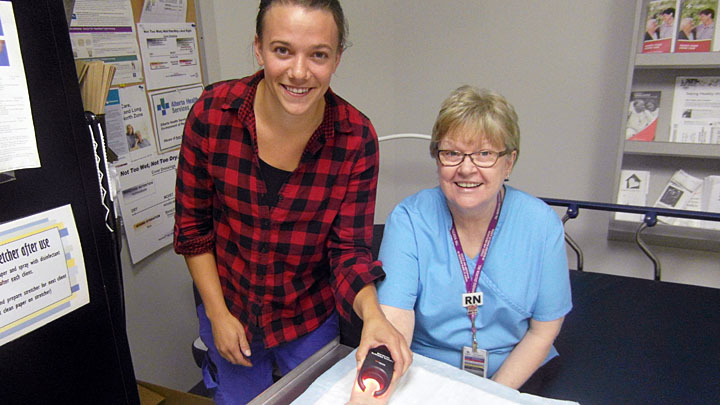
August 19, 2016

Registered nurse Natalie Senez, left, demonstrates a new vein viewer on her seated colleague, RN Kaye Schultz how. The new equipment, which helps them to locate veins and start IVs easier, was purchased to help home care patients in the Cold Lake area.
Story by Kerri Robins; photo courtesy Tracey Hofer
COLD LAKE — Difficult IV starts are becoming a thing of the past for home care patients in the Cold Lake area, thanks to a new vein viewer that helps staff locate a patient’s veins quickly and non-invasively.
Home care registered nurse Kaye Schultz says she’s happy with the new equipment. “The new vein viewer is nice because we can now find our client’s veins much easier, with less poking around.”
The new equipment helps caregivers “see” patients’ veins through their skin when starting IV’s to treat dehydration or to collect blood samples.
Anne Tucker, Area Manager, Seniors Health for Cold Lake Community Health Services, agrees with Schultz on the benefits of the viewer.
“It’s a non-invasive, simple procedure,” she says, “and while we use this particular vein viewer on our home care patients, we can use it on all patients from pediatrics to geriatrics.”
The mobile, hand-held device shines harmless near-infrared (NIR) light on the patient’s skin to detect a vein or particular vein pattern. The vein shows up green or grey.
Funded through the Cold Lake Health Centre Auxiliary, two vein viewers were purchased and arrived in June, at a cost of $1,300 each. They will be used specifically for home care patients in Cold Lake and surrounding area.
Genetics often play a role in making some patients’ veins harder to find, while medical conditions are to blame for others, and can cause veins to collapse.
“We usually ‘feel’ for the vein when collecting blood samples, but some patients’ veins are tougher to find, for example, someone whose been through chemotherapy,” says Tucker. “It’s much nicer locating the vein with the viewer than having to guess where to insert the needle.”
“It’s nice to be able to use the viewer to help start intravenous drips and not have to cause any unnecessary pain for our patients,” adds Tucker, “and it’s easy to clean — which is great for infection control standards.”
The auxiliary also recently funded a $1,400 portable suction unit for the use of long-term care residents at the Cold Lake Healthcare Centre. The unit is used to drain fluid from the lungs or back of the throat.
“Some of our seniors have difficulty breathing and swallowing,” says Tucker, “so the portable unit is nice because we can bring it to their room without having to move them.” Sheila Smith, Interim President of the auxiliary as well as coordinator of the gift shop managed by the auxiliary, has been a member for 18 years.
“I’ve been in health care all my life,” says the 73-yr-old ex-nurse from Cold Lake. “I’m thrilled to be part of this great group of ladies because the environment really suits me. “The gift shop is a great place to be because I enjoy people. But the best thing is that I’m able to support our local health care doing something I love.”
The 20-member auxiliary, which has been around for 30 years, raises about $10,000 a year through bake sales and gift shop proceeds.
Tucker says she’s grateful for the auxiliary and their level of dedication and commitment to health care.
“I can’t thank these ladies enough,” she says. “This is a hard-working group with a lot of energy and drive, and we are really fortunate to have them working on our behalf.
“My hat goes off to all the ladies in helping us maintain such excellent care throughout the region.”
For more information on health care fundraising in Alberta, please visit www.ahs.ca/give.